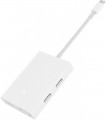USB version
This paragraph refers to the USB connection interface. Refers to both the classic USB A and the type C port. The main difference between the interface versions is the bandwidth — speed.
—
USB 2.0. The outdated version 2.0 provides data transfer rates up to 480 Mbps. Found only in USB A ports.
—
USB 3.2 gen1. The previous names of the USB 3.1 gen1 and USB 3.0 standard (they know how to confuse). Unlike 2.0, this version provides 10 times the maximum speed (4.8 Gbps), as well as higher power supply, which allows you to connect power-hungry devices and extensive splitters.
—
USB 3.2 gen2. Further improvement of the USB 3.2 gen1 standard (and, as is customary, the previous name USB 3.1 gen1 and simply USB 3.1, which was renamed more than once), made it possible to achieve a maximum speed of 10 Gbps and even higher power for external devices.
USB А
The number of USB inputs located on the case of the card reader or hub (see "Type"). The number of USB ports that you will have at your disposal after connecting the device depends on this parameter. "Pure" card readers and combined models, usually, have 1,
2 and even
3 USB inputs, while hubs have
4 or more ports.
USB A version
This paragraph refers to the USB connector interface. The main difference between the interface versions is speed. It is worth noting that the speed of the input connector does not yet indicate the overall throughput, since the simultaneous connection of
flash drives,
phones, memory cards slows down data transfer, which anyway is limited by the interface for connecting the device itself to a PC or
laptop(item "Connection interface").
- USB 2.0. The outdated version 2.0 provides data transfer rates up to 480 Mbps. Found only in USB A ports.
- USB 3.2 gen1. The previous names of the USB 3.1 gen1 and USB 3.0 standard (they know how to confuse). This version provides 10 times the maximum speed (4.8Gbps) as well as higher power supply, which allows you to connect power-hungry devices and large splitters.
- USB 3.2 gen2. Further improvement of the USB 3.2 gen1 standard (and, as is customary, the previous name USB 3.1 gen1 and simply USB 3.1, which was renamed more than once), made it possible to achieve a maximum speed of 10 Gbps and even higher power for external devices.
HDMI
HDMI is the most popular of today's multimedia digital interfaces. It is specifically designed for HD content and delivers high-definition video and multi-channel audio over a single cable.
HDMI outputs are found mainly in hubs connected via USB Type C and compatible with the Thunderbolt interface (see "Connection"). Actually, to use HDMI, you will need to connect the device to the Thunderbolt v3 connector — "pure" USB Type C does not provide video transmission. This feature can be useful if the external screen is designed for HDMI connection, but there are no such connectors in the PC or laptop itself, they are busy or unavailable for another reason. At the same time, HDMI can be a different version, which affects the throughput. So to transfer video in 4K at 60 fps, you must have
HDMI v 2.0 or 2.1.
VGA
The presence of a VGA output in the design of the device.
VGA is an analogue interface originally designed for CRT monitors; it supports resolutions up to 1280 by 1024 and does not include audio. Today, this standard is considered obsolete; nevertheless, it is still found both in some monitors and in various specialized video equipment (in particular, projectors). The presence of a VGA output allows you to use the hub as an adapter for connecting a VGA device to a computer or laptop that does not initially have such an output. However, such a need arises infrequently, and hubs with a VGA output are not widely used.
LAN (RJ-45)
The presence
of a LAN connector (RJ-45) makes it possible for the card reader/hub to work as a LAN adapter.
This port is commonly used for wired connection to computer networks. This connection may be preferable to wireless in some situations, but some devices (such as ultra-thin laptops) may not have a native LAN port. And in a PC, where such a port is usually installed on the back of the case, it can be much more difficult to get to it than to the USB connector. For such cases, card readers / hubs with a built-in LAN adapter are designed — usually, these are external devices connected via USB and capable of operating as an external network card.
Cable length
The length of the cable supplied with the device. Mostly relevant for models with a non-removable cable that cannot be replaced.

